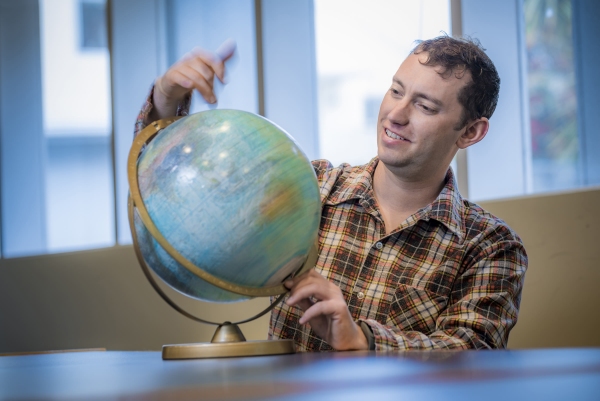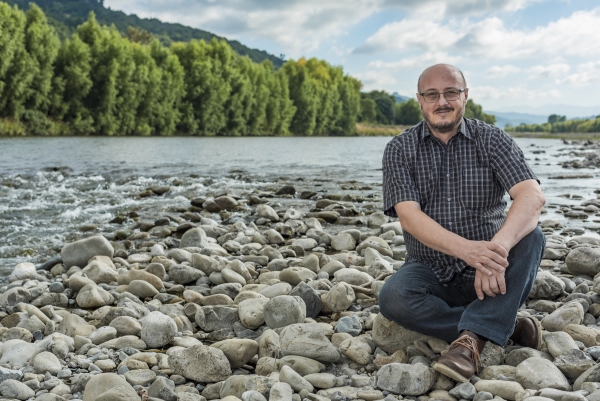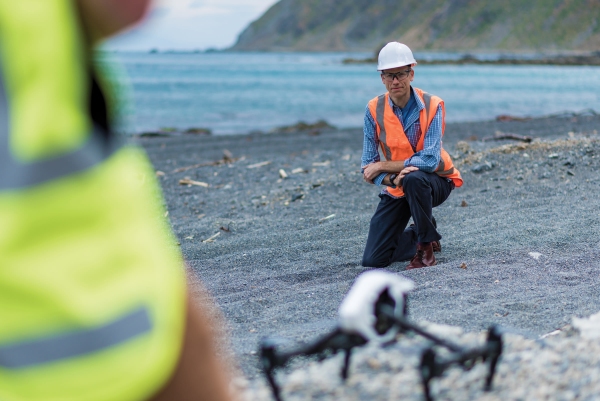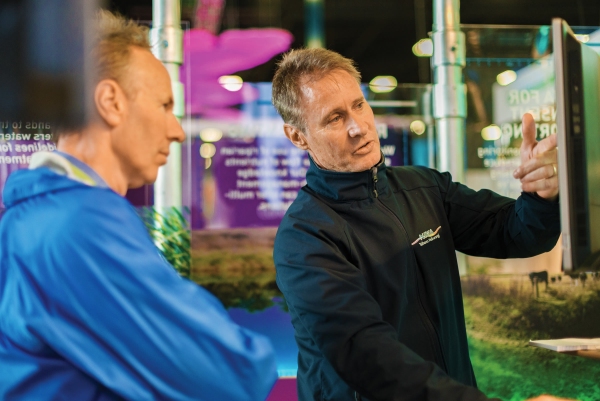Massive increases in computing power are allowing NIWA scientists to not only analyse more data, faster, but also to envisage completely new experiments.
Fifty years ago, the BBC’s science programme Tomorrow’s World showed a computer terminal in a suburban home and famously predicted that they would be in every house in the future. The descendants of those rudimentary terminals have transformed our daily lives.
Computers have also transformed the possibilities of science. The home computer in Tomorrow’s World was connected via phone line to a large ‘mainframe’ computer. At this time, the world’s first successful mainframe supercomputer, the CDC 6600, was humming away in science labs such as the Los Alamos National Laboratory in California and CERN in Switzerland.
Computing speed is central to the exploration of possibilities by science. The drive for ever faster processing speeds has seen ever increasing magnitudes of improvement over the 50 years since the CDC 6600.
By 1985, 20 years after the CDC 6600, the Cray 2 supercomputer ran more than 25 times faster. The best supercomputer in 2000 was 19 times faster than the best in 1995. The best in 2005 was 1,650 times faster. The best in 2010 was 15,100 times faster.
The difference can be shown in the spin-off effects for consumer technology. The Nintendo Entertainment System (NES) games console released in the early 1980s was twice the speed of a 1960s supercomputer. The new Apple Watch is faster than the 1980s Cray 2.
Following this development trajectory, New Zealand's supercomputing capability has just taken a quantum leap (see Panorama, pp. 8–9). The latest Cray XC50, NIWA’s newest supercomputer, runs at one petaflop in a single box, and up to 500 petaflops in a fully joined-up supercomputer.
When installed, the entire upgrade suite of NIWA’s supercomputers will be about 13 times more powerful than NIWA’s previous IBM supercomputer, and will use about two-thirds of the electricity.
Expanding vision
Lloyd Trefethen of the Oxford Computer Laboratory said that, although computers were not as wise as people, they could “explore a forest of possibilities faster than we can”. Computational power is at the heart of the difference supercomputers make to NIWA scientists.
“Every time we’ve bought a new supercomputer, it’s challenged our concepts of what’s possible – it takes us a couple of years for our science to catch up with the technology. It expands our vision,” says Dr Sam Dean, Chief Scientist for NIWA’s Climate, Atmosphere & Natural Hazards Centre.
He says the most exciting prospect opened up by the Cray XC50 is convective-scale weather modelling of our future climate.
“We will run the same model we use for our weather forecasting, but will run it decades into the future.”
The computing speed means NIWA could more quickly generate very long-range forecasts like those produced for the Greater Wellington Regional Council. They projected a climate for the Wellington region in 2090 similar to Sydney’s current climate.
Climate simulations
Climate simulations are about to get far more detailed thanks to NIWA's earth system modellers, funded by the Deep South National Science Challenge.
NIWA earth system modeller, Jonny Williams, has only been able to run a simple version of its climate model.
“Until now, we’ve had to run simpler versions of the model – a bit like running a modern app on an old phone.
“When we have use of the new machines, we will for the first time be able to run our full earth system model. We’ll be able to do advanced science, much faster.
“The first step will be to validate the model with our overseas partners. Then we’ll be working on an Aerosol Chemistry model, which will contribute to the next IPCC [Intergovernmental Panel on Climate Change] assessment report.
“We’ll be running several simulations in collaboration with the UK Met Office. As a group, we’ll be feeding these into a database, which will be publicly accessible for anyone in the world.”
Apart from contributing to the global understanding of our changing climate, a key aspect of NIWA's science programme is to grow New Zealand’s capacity to develop and perform earth system modelling. The research will also address a common flaw in many global climate models – how well we represent the Southern Ocean region, including sea ice, ocean circulation, and clouds.
Freshwater modelling
The new supercomputer will be used to generate new climate change simulations covering 66,000 New Zealand catchments, says NIWA hydrologist Dr Christian Zammit.
Each simulation models at least eight hydrological variables (surface runoff, groundwater recharge, soil and canopy evaporation, groundwater discharge to stream, discharge in stream, snow storage and snow-covered area.
“We estimate that these models will generate over a petabyte (a million gigabytes) of simulation results – that’s only achievable with the new supercomputers,” Christian says.
The results will be used by regional councils, consultants, central government, and CRIs and will feed into the next generation of climate change forecasts by the IPCC.
“As part of the National Hydrological Project, we are planning to run simulations of a loosely coupled surface water/groundwater model across New Zealand.
“First simulations will start to be carried out in three catchments across New Zealand (in Southland, the Horizons region and Gisborne) with the aim of extending those simulations across the new digital river network (called DN3, which will contain over 4 million reaches) and providing 50-year hydrological ‘hindcasts’ (predictions of historic conditions).
Zammit is excited at other possibilities opened by the computing power, such as better flood prediction and assistance to allocation for water for use in sectors such as farming.
"Our work is contributing to the continual improvement in earth system and climate modelling worldwide, which is crucial if we are to better understand and adapt to our changing climate."
Helping manage big data
Dr Matt Pinkerton is thinking of using the computer power to crunch satellite imagery and other data so people can get a better sense of land and water use.
The Principal Scientist, Marine Ecology says NIWA uses satellite observation of the ocean for core research on the structure and functioning of New Zealand marine ecosystems.
“There’s so much more satellite data than we can fully use. There are more satellites, with higher spatial resolution and greater spectral resolution. An increasing availability of information brings great opportunities in a traditionally data-scarce research area.
“Getting the most out of these new earth observation satellites in the future, for example by assimilating satellite data into ocean models, will rely on the capability provided by a supercomputer.
“A supercomputer can look at more data, faster, than we have to date. It can identify sea changes in fisheries, and the effects of human activities such as aquaculture and seabed mining.”
Pinkerton is thinking even further ahead, to how a supercomputer can assess the great volumes of satellite imagery to help regional councils manage land use from the sky.
“Spatial management can be transformed by the power of a supercomputer to help us monitor and analyse what satellites see us doing with the land.”
Counting farm sensors
The sensor revolution is already well underway. Sensors remotely monitor heart rate and medicine intake, adjust production lines to conditions, and feed data from remote instruments. In New Zealand, farmers use them to report on conditions such as soil moisture and acidity.
Gartner research estimates there are over 6 billion sensors connected to the internet. There could be 20 billion of them by 2020.
The concept of an ‘internet of things’ envisages a world where multiple devices and sensors are connected and communicate. All those sensors produce an incredible amount of data. This data could be analysed to make more accurate predictions and insights.
Only supercomputers can hope to gather, synthesize, and understand enormous amounts of sensor data at speed.
NIWA is part of a pilot project running incredibly sophisticated sensor networks on New Zealand farms, and analysing the data to improve on-farm decision making.
While the concept is often imagined by futurists, it has not yet been properly attempted in New Zealand. The pilot wants to work out what all that data looks like, and how it can be aggregated, compared with other information, and used to provide truly helpful guidance in running farms.
One part of the project focuses on installing battery-powered sensors on a low power local wireless network. The other focuses on analysing the tens of thousands of data points from each farm.
Dr Mark Bojesen-Trepka, NIWA’s Manager of Industry Engagement, says the pilot will turn concept into reality, to build data-driven decision tools.
“We’re building the hard reality of a data-powered future: discovering how much data we get, how to analyse it, and how to produce guidance and decisions that improve farming operations.”
The pilot envisages feedback in real time. For example, farmers will be able to match weather forecasts with actual weather over their farm, and how specific rainfall volumes and periods affect the moisture content of soil. That knowledge can be used to guide decisions such as when and how much fertiliser is needed, and crop growth projections for sequencing grazing or harvesting.
“Each paddock will have its own dataset. The NIWA supercomputer can work through huge amounts of data in super-quick time – so farmers can see what is happening across their property in real time, and act on that information,” he says.
Bojesen-Trepka says there will be significant gains in pooling data from multiple farms, providing a chance to contrast and compare farming techniques.
“The supercomputer will learn from the sensors the effects of different techniques on each farm. It can apply that knowledge to new recommendations for things each farmer can try.”
The project could have benefits for the whole nation. Bojesen-Trepka envisages a time when weather sensors on every farm in the country feed data into a nationwide weather forecast.
“The accuracy of our current 485 official weather stations could be augmented by data from 10,000 smaller weather sensors scattered across rural New Zealand,” he says.
Deep learning
Artificial intelligence has captured the popular imagination, but also the imagination of scientists.
Algorithms that help machines learn have created sophisticated classification and prediction models, commonly known as deep learning. These are outperforming traditional approaches to enabling computers to ‘see’, and to recognise and translate speech and natural language.
NIWA’s supercomputer can adapt deep learning techniques to scientists looking at the natural world. It will allow rapid prototyping of machine learning models and algorithms.
One example is Dr Krista Hupman’s (NIWA) cetacean Photo ID project, which is creating a fully computer-automated system for identification of individual cetaceans from photographs and video captured in the field. The first stage of the system, a collaboration between Hupman and Massey University researchers Dr Andrew Gilman and Dr Matthew Pawley, is already online. It’s being used by cetacean scientists from the US National Oceanic and Atmospheric Administration (NOAA).





